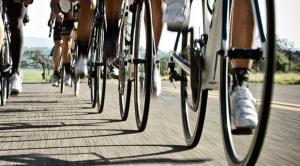There is market share. And then there is an abject stranglehold on a market segment. If the Slowtwitch community of readers is any gauge, Continental has its hands around the throat of the triathlon market, leaving Vittoria, Michelin, Specialized, Schwalbe and all the other tire makers gasping for air.
Do facts, specs and performance justify this? Triathlon is a notoriously difficult market to track and quantify. Tire market share among triathletes is unknown, but below is the market preference of just over 1,100 Slowtwitchers who took our tire polls.
Let’s quantify stranglehold. Slowtwitchers at a rate of 71 percent indicated a preference for Conti for use in triathlon. No other brand had a market preference of more than 6 percent. Specialized, Michelin, Schwalbe were next in line.

Among Continentals tires, the 4000S II was the clear favorite. Seventy percent of Slowtwitchers who choose Conti choose this tire. Well behind this model trailed the Supersonic, Attack and Force (along with the 4000S II, the models most highly regarded for speed and race performance). These are all clincher tires. Following these 4 models was Continental’s tubular (sew-up) tire and then its tires known for durability, puncture resistance and good lifespan (Four Seasons, Gatorskin).
Continental got to its current market position fair and square and by doing everything right. Its tires did not test especially well (in rolling resistance) prior to the introduction of its Black Chili tread formulation. This sped up its tires and the 4000S II tested well aerodynamically (by design or accident). It was relatively resistant to punctures for a tire of this speed quality. It hit all its marks.
Black Chili was the secret sauce and Conti’s performance tires using a Black Chili tread were fast. Helping the effort, at the time, was the ability to get these tires pretty cheaply from the UK. If customers were patient a sale on bulk Conti tires would occasionally come up on Chain Wiggle or ProBikeKit. More recently Conti has thrown a lasso around global prices (some brands fare better than others at this), but the prices on the 4000S II are very fair at $35 to $40 each when purchased here in the U.S.

Then there is the ubiquity of this tire. U.S. retailers know how popular this tire is and stock it liberally. It is distributed by both QBP (which supplies all bike shops) and many or most of the field sales representatives calling on bike shops from Highway2 (the tire’s importer) also rep Zipp and SRAM (so Conti has strong field sales representation).
This tire is available both in 700c and in 650c. It’s available in 23mm, 25mm and 28mm widths. There is nothing not to like about the 4000S II.
And that’s just what you all know about. Behind the scenes Continental has been a very good industry citizen. When one wheel maker asked Continental for help in the aero testing of its wheel, Continental agreed to hand sort and provide 30 tires from that single mold to use for testing.
As Sam Spade (Bogie) said, in The Maltese Falcon, “That’s all on the one side.”
The 4000S II was a world beater when introduced. It was very simply the best clincher tire a triathlete could put on his bike. You were nearly justified in asking why the market preference was anything less than 100 percent.
But the 4000S II was introduced in 2013. It’s 2017 as of this writing. The other tire companies have not been standing still. Before Black Chili, Zipp, Michelin, Bontrager and others all had compelling tires and persuasive arguments. Every company but Conti was back on its heels after the intro of the 4000S II. But they didn’t throw in the towel.

And now some of these companies are throwing down. Specialized has gradually become more confident in its tires, especially the Turbo Cotton (above). I love this tire’s throwback gumwall cotton casing. It reminds me of Clement silk and cotton tubies. I didn’t notice this until I put them on my bike, pumped them up, and then looked at the bike. I was transported. This won’t appeal to any of you, but I saw my bike through a prism and it looked like something Agostinho (forte!) or Zootemelk might hike his leg over.
But it isn’t just the walk down memory lane. This tires can roll! In Jarno Bierman’s (BRR) testing the Turbo Cotton saves a rider almost 3 watts per pair and before you tell me that’s not enough to warrant a change tell me all the aero upgrades you’ve purchased and let’s see what consideration you received for what you paid.
Michelin was a darling of timed race performance clinchers in the early 2000s. the 4000S II left Michelin in the dust and relatively few people noticed this venerable French brand rising from the dust, like at phoenix, last year. Michelin’s new Power line of performance tires features the Power Competition (below) and BRR has this tire 1.3 watts faster per tire. It has puncture resistance about on par with the Conti, is very slightly lighter, and comes in 3 widths. Its aero performance is unknown (by me) but I’d be surprised of Michelin didn’t notice the aero performance of the 4000S II (which has been known for better than a decade) and reproduce a similar silhouette in its Power Competition.
That 1.3 watts is at 18 miles per hour, which means more like 2 watts at 24mph and 4 watts per the pair. This Michelin tire costs $15 or $20 per tire more than the 4000S II. For some, 4 watts enough to reconsider Conti.

Hutchinson, Schwalbe and Vittoria each have terrific tubeless tires fairly recent to the market. The Vittoria Corsa Speed tests about 12 or 14 watts faster per pair than the 4000S II, at 22 to 24 miles per hour! But only if you use the 100 gram butyl Conti Race 28 tube. If you replace these with latest tubes that gap closes by 4 or 5 watts per pair. (Plus, have you tried to stretch a Vittoria Corsa Speed over a rim? I have. No fun.)
Is tubeless viable? Yes. About 80 percent of the desirable aero wheels today are tubeless ready. By some industry estimates the great majority of the tire R&D right now, for skinny tire applications, is in tubeless. Betting that tubeless is the future is not an unwise wager.
Does Continental deserve to have 7 out of 10 Slowtwitchers choose this brand? Yes, when you realize that this company has done so much right; that for 3 years the prevailing advice on Slowtwitch has been to buy this tire; that the price and availability and range of width and diameter options make it so that it’s never an unwise decision to buy this tire.
No, when you realize that a case can be made that other tires are the equal or better. Triathletes are iconoclasts. They don’t want to follow the pack. They do look for an edge. Based on everything I have perceived as a spectator of the market, Conti’s market share is not sustainable based on today’s tire offerings. Conti does deserve to be the number-1 tire seller in triathlon. But the facts don’t support unit sales more than twice the rest of the market combined.



